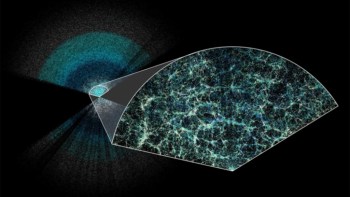
A controversial claim by the DAMA group that it has detected dark matter in an underground lab in Italy might turn out to be true after all, according to physicists in Europe and the US. The new research reconciles the claimed detection with apparently null results from other experiments, as well as indirect astrophysical evidence. It proposes that dark matter interacts with ordinary matter not via one of the four known fundamental forces but instead through a fifth force mediated by an axion-like particle.
Dark matter is an as-yet-unknown substance that does not emit electromagnetic radiation but which numerous observations suggest makes up at least 80% of the matter in the universe. DAMA, a collaboration of physicists from Italy and China, says it has directly observed dark matter in a sodium-iodide detector located beneath Gran Sasso mountain east of Rome. The basis for its claim is a seasonal variation in the number of tiny flashes of light that should occur when dark matter collides with nuclei in the detector. The group argues that this variation – which peaks in June and has a minimum in December – is just what would be expected as the Earth moves through a “halo” of dark matter surrounding the Milky Way.
Discovery or background effect?
Having collected a whopping 1.33 tonne-years of data, DAMA says there is almost no chance that its results are a statistical fluke. It now reports a confidence level of 9.3σ, which is well above the 5σ usually required for a discovery in particle physics. The problem is that a number of rival groups operating different kinds of detectors have reached sensitivities that they say should have allowed them to also detect dark matter, assuming the DAMA claim to be correct, but that they have failed to do so. While there is little doubt that DAMA has detected an annual modulation, many physicists take issue with the group’s interpretation of its results. Some argue that the modulation could simply be a yet-to-be-determined background phenomenon.
However, as pointed out by Eugenio Del Nobile of the University of California,Los Angeles, such exclusions rely on theoretical assumptions about the kinds of interaction taking place inside the detectors. In the latest work, Del Nobile and two colleagues – Chiara Arina of the University of Amsterdam and Paolo Panci of the Institut d’Astrophysique de Paris – have shown how a certain kind of force-mediating particle can reconcile the various experimental results.
Unlike the force-carrying particles of the Standard Model, which have a spin of 1, the proposed particle is spin-0. In that sense it is like the famous Higgs boson, which is known as a “scalar” particle. However, unlike the Higgs boson, the quantum state of the new particle changes when its spatial co-ordinates are reversed, a property that earns it the title “pseudoscalar”. This also makes it similar to the hypothetical axion, which is another contender for dark matter.
A new spin on interactions
This asymmetry would make any collisions between incoming dark-matter particles and detector nuclei sensitive to the spin of those nuclei. Protons and neutrons would organize themselves into pairs with opposite spin to minimize the energy of the nucleus, and consequently interactions would involve, at most, a single unpaired proton or neutron. This contrasts with the “spin-independent” interactions generally assumed to take place inside detectors. These involve a summing across all protons and neutrons, and are therefore much stronger – which is why some detectors use heavy targets such as xenon.
To calculate the effect of the pseudoscalar mediator, Del Nobile and colleagues assumed that it acts equally on all quark types – quarks being the fundamental components of protons and neutrons. This, they explain, results in dark matter interacting much more strongly with protons than with neutrons. And as they point out, that would favour DAMA as a dark-matter target, because its constituent sodium and iodine nuclei contain odd protons. Other dark-matter detectors use xenon or germanium, which contain odd neutrons. This would therefore be much less sensitive than DAMA and explain why DAMA alone has measured a strong annual signal.
The team has also shown that the pseudoscalar interaction could explain an excess of gamma rays observed at the centre of the galaxy in terms of annihilating dark-matter particles. Del Nobile stops short of arguing that his group’s analysis now makes it more likely that DAMA has seen dark matter, cautioning that the work involved simplifying the properties of the galactic dark-matter halo. But he says the onus is now on rival experimental groups to “spell out their assumptions” when claiming to have ruled out the DAMA result. He adds that the pseudoscalar model could be tested at colliders producing K or B mesons.
Unnecessary complication
However, Juan Collar of the University of Chicago believes that Del Nobile and colleagues might have complicated things unnecessarily. Has the DAMA dark-matter mystery been solved at last? Collar, who has provided tentative support for the DAMA claim by observing a statistically limited annual modulation in data from the CoGeNT dark-matter detector in the US, says that the apparent conflict between experimental results might be resolved if dark matter were to collide with electrons, rather than nuclei. “Having said that,” he adds, “I think it is very interesting that these authors can still find room to wiggle while limiting themselves to nuclear-recoil interactions.”
The research is described in Physical Review Letters.



